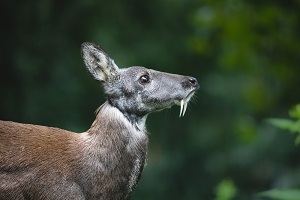Environmentalists Identify New Habitat for Musk Deer Population with support from Vostsibneftegaz

With grant support from the East Siberian Oil and Gas Company (Rosneft’s oil and gas production enterprise), scientists from the Central Siberian State Nature Reserve have identified new habitats and studied the population of the musk deer, a rare species of cloven-hoofed animal that inhabits the Evenki municipal district of Krasnoyarsk Territory.
Environment protection is an integral part of Rosneft Oil Company’s corporate culture and one of the key priorities of its business. Reaffirming its commitment to achieving sustainable development goals, the Company implements a number of programmes to preserve the favourable environment and biodiversity in the regions of its operations.
Evenkia is the northernmost limit of the musk deer range, and the current natural and climatic conditions of the area present difficulties for the natural dispersal and increase in numbers of the species. Furthermore, its secretive lifestyle makes the musk deer almost unnoticeable.
The data obtained from the research have not only confirmed the presence of the population in Evenkia (an area previously considered unsuitable for this animal species), but have also helped scientists estimate the size of the population at around 300 individuals. The scientists associate the settlement of the musk deer in the North with global warming processes, which create a food base for the animals and allow them to settle in new ecologically favourable areas away from human activities.
The experts studied satellite images and traces of the musk deer and analysed the materials collected, which revealed the foraging base and narrowed down the area where the animal could find its habitat. Eight camera traps were set up in the most suitable feeding areas of the musk deer in the Podkamennaya Tunguska River basin, from the Lebyazhka River to the Velmo River, and more than 16,000 photos were processed.
The Central Siberian Nature Reserve has developed a number of measures to protect the new species. First and foremost, it’s about the protection of this small population from natural predators, such as wolves and bears. Another promising way of preserving the species is to set up a breeding and cage-keeping site for the Siberian musk deer. This will not only preserve the population, but also will create additional jobs for the indigenous peoples of the North.
Note for Editors:
The Siberian musk deer is the smallest reindeer animal to be found in Russia. Maximum withers height is 71 cm for males and 69 cm for females.
The East Siberian Oil and Gas Company, a subsidiary of Rosneft Oil Company, develops the Yurubcheno-Tokhomskoye oil and condensate field in the Evenki district of the Krasnoyarsk Territory.
Supporting the traditional way of life of the indigenous people of Evenkia is one of the key lines of the social work of the company. During the years of the work in the region, Vostsibneftegaz has implemented a lot of social, charitable and grant programmes. The oil workers have supported more than 20 scientific projects, including those on the study of the wild reindeer population—a bioindicator species of the Arctic zone, the Siberian sable and the red-listed lesser white-fronted goose. The enterprise is also developing the first Red Book of Evenkia, working to preserve the Evenki language, studying the ecosystems of the Tunguska Nature Reserve, and engaged in the artificial reproduction of the Siberian taimen.
The implementation of the grant schemes helps save the unique natural environment, national culture, traditional way of life and cultural authenticity of the indigenous population of Evenkia.
Rosneft
Information Division
February 3, 2023